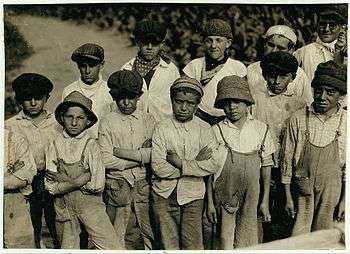Connecticut shade tobacco
Connecticut shade tobacco is a tobacco grown under shade in the Connecticut River valley of the U.S. states of Connecticut, Massachusetts, and southernmost Vermont, and is used primarily for binder and wrapper for premium cigars.

History
Tobacco farming in the Connecticut River valley has a long history. When the first settlers came to the valley in the 1630s, tobacco was already being grown by the native population. The town of Windsor is the epicenter of the tobacco industry in Connecticut. The town was founded in 1633 and within seven years it was producing tobacco for personal use and profit. The tobacco being grown was for pipe use, brought up from Virginia since the tobacco variety found in the Connecticut Valley was not as delectable as the Virginian style. It was immediately apparent that the soil from the river, a rich sandy loam, and the hot and short summer of New England yielded an excellent crop each year. Approximately 34,000 acres (140 km2) of land in Connecticut is covered by Windsor Soil, named after the town of Windsor.[1]
Eventually, the popularity of cigars became greater than the pipe. Initially, a tobacco leaf type named Shoestring was grown. This was replaced by Broadleaf tobacco, which was the variety that dominated the industry. It was in such high demand that during the Civil War the Connecticut Valley yielded up to ten million pounds per year. The fame of quality Connecticut tobacco was raved about throughout the settled regions of the United States.[2]
By 1700, tobacco was being exported via the Connecticut River to European ports. The use of Connecticut Valley tobacco as a cigar wrapper leaf began in the 1820s. Area farmers grew tobacco for the two outside layers of cigars, the binder and the wrapper. By the 1830s, tobacco farmers were experimenting with different seeds and processing techniques.[3] Knowing that they were not the only players in the cigar wrapper economy, farmers began planting a new tobacco species in 1875, the Havana Seed. This smooth, good-looking leaf yielded a higher percent of quality cigar wrappers.
Just a few decades later, in the late 19th century, a fine grained leaf type imported from Sumatra was adopted for growth in Connecticut.
The demand for high quality cigar wrapper was never ending. This pushed Connecticut growers and scientists to develop a leaf so smooth and golden that it would dominate the market. Farmers and scientists worked together to develop a hybrid to overcome competition from Cuba and Asia. Using over thirty samples from Cuba and Sumatra, Shade Tobacco was born in 1900, and the first shade-leaf tent was put up on River Street in Windsor. The shade tents made of cloth cut sunlight and raised humidity.[4]
The technique of growing shade tobacco has changed little in the past hundred years. To form the shade tents, a tobacco field is set with posts in a grid layout. Wires are stretched from post to post, and a light, durable fabric (once cotton but now a synthetic fiber) is tied across them and draped along the sides. For example, twenty posts in four rows of five will create twelve square cells in three rows of four. Under the tents the sunlight is soft and diffused, the air is humid, and the ambient temperature is slightly warmer than outside. Filtering the sun produces a thinner and more elastic tobacco leaf that cures to a lighter, even color often desired by the Cuban and Dominican cigar producers.
The 1920 Prohibition ceased legal sales of alcohol in Connecticut, and tobacco production consequently reached a peak in Connecticut.[5] At its height, there was greater than 20,000 acres (81 km2) of tobacco being cultivated under shade in the Connecticut Valley. Currently, the amount of tobacco being grown in the valley is just over a steady 2,000 acres (8.1 km2).[4]
Windsor tobacco leaves are highly prized by fine cigar makers, and are used as the cigar's outer wrapping. The former president of U.S. operations for Davidoff, a Swiss maker of luxury goods including premium cigars, praised Connecticut shade tobacco as "[a] nice Connecticut wrapper" and "very silky, very fine. From a marketing point of view”, and “one of the best tasting and looking wrappers available", in a 1992 Cigar Aficionado article on why the world's best cigars use Connecticut tobacco wrapper leaves.[3]
By 2011, plantings were down to about 700 acres a year, and by 2017 those plantings had declined about 80%.[6] So in 2017, one of the largest producers of shade grown tobacco, O.J. Thrall, placed over 300 acres of prime tobacco growing land up for sale. Pockets of the crop remain in production in Connecticut towns such as Windsor, East Windsor, Suffield and Enfield.[6]
In popular culture
The 1952 novel East of Eden by John Steinbeck is set partially on a farm in Connecticut, where character Charles Trask improves the land in part by planting tobacco.
The 1958 novel and 1961 motion picture titled Parrish featured the shade tobacco industry in and around Hartford in the '40s and '50s.[7]
References
- "CT Soils – Windsor | Connecticut NRCS". Ct.nrcs.usda.gov. Retrieved 2013-11-20.
- Dunlap, Bri. "Director". The Luddy/Taylor Connecticut Valley Tobacco Museum. Retrieved 3 February 2015.
- "Wrapped Up". Cigar Aficionado. No. Winter 1992. 1992-12-01. Archived from the original on 2009-05-19. Retrieved 2009-10-12.
- "Connecticut Valley Tobacco Historical Society". Tobaccohistsoc.org. Archived from the original on 2009-09-18. Retrieved 2009-10-12.
- Dunlap, Bri. "Director". The Luddy/Taylor Connecticut Valley Tobacco Museum.
- "Foreign Competition, Labor Costs Push Connecticut Shade Tobacco Farmers To The Edge". Gregory B. Hladky, Hartford Courant, June 15, 2017. Retrieved July 8, 2020.
- "Parrish (1961) FAQ". IMDb. IMDb.com, Inc. Retrieved 8 October 2018.